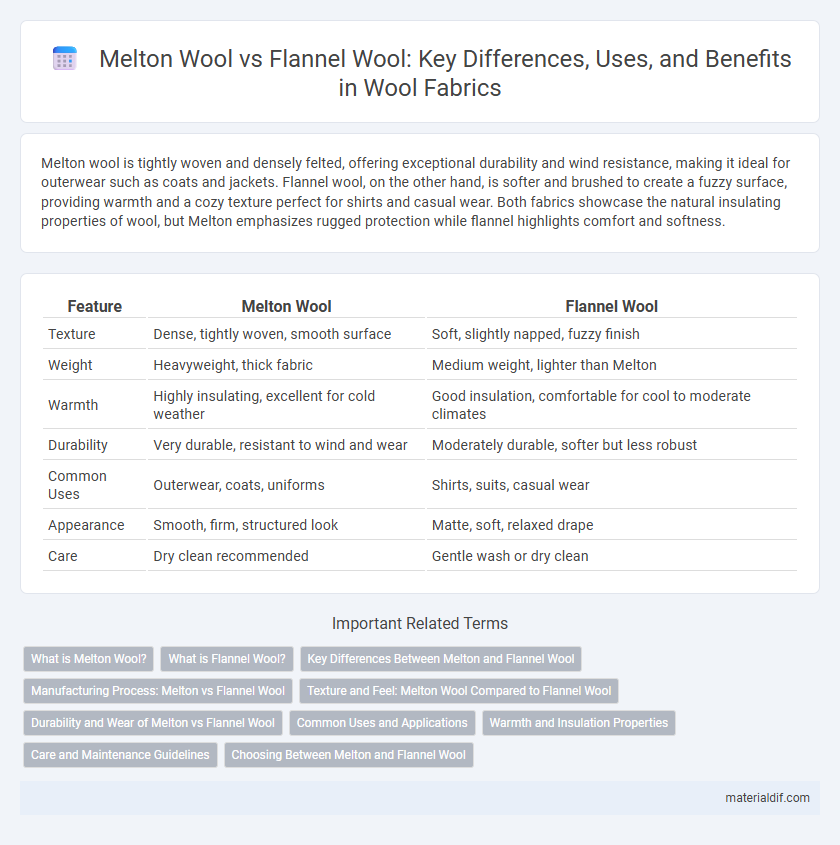Melton wool is tightly woven and densely felted, offering exceptional durability and wind resistance, making it ideal for outerwear such as coats and jackets. Flannel wool, on the other hand, is softer and brushed to create a fuzzy surface, providing warmth and a cozy texture perfect for shirts and casual wear. Both fabrics showcase the natural insulating properties of wool, but Melton emphasizes rugged protection while flannel highlights comfort and softness.
Table of Comparison
| Feature | Melton Wool | Flannel Wool |
|---|---|---|
| Texture | Dense, tightly woven, smooth surface | Soft, slightly napped, fuzzy finish |
| Weight | Heavyweight, thick fabric | Medium weight, lighter than Melton |
| Warmth | Highly insulating, excellent for cold weather | Good insulation, comfortable for cool to moderate climates |
| Durability | Very durable, resistant to wind and wear | Moderately durable, softer but less robust |
| Common Uses | Outerwear, coats, uniforms | Shirts, suits, casual wear |
| Appearance | Smooth, firm, structured look | Matte, soft, relaxed drape |
| Care | Dry clean recommended | Gentle wash or dry clean |
What is Melton Wool?
Melton wool is a dense, tightly woven fabric known for its exceptional durability and wind-resistant properties, making it ideal for outerwear such as coats and jackets. It undergoes a fulling process that creates a smooth, felt-like surface with minimal nap, distinguishing it from flannel wool, which features a softer, brushed texture. This structured finish enhances Melton wool's warmth and weather resistance, providing superior insulation compared to the more breathable and lightweight flannel wool.
What is Flannel Wool?
Flannel wool is a soft, napped fabric made from carded wool fibers, known for its warmth and smooth texture. It undergoes a brushing process that raises the fibers, creating a fuzzy surface ideal for insulated clothing and cozy garments. Compared to Melton wool, which is denser and tightly woven, flannel wool offers more flexibility and breathability while maintaining excellent heat retention.
Key Differences Between Melton and Flannel Wool
Melton wool features a dense, tightly woven texture that provides superior wind and water resistance, making it ideal for outerwear like coats and jackets. Flannel wool offers a softer, brushed surface that enhances warmth and comfort, commonly used for shirts and casual garments. The key differences lie in Melton's heavy, compact finish versus Flannel's plush, fuzzy feel, impacting their insulation and durability properties.
Manufacturing Process: Melton vs Flannel Wool
Melton wool undergoes a fulling process that compresses and felts the fibers tightly, resulting in a dense, smooth, and durable fabric ideal for outerwear. In contrast, flannel wool is woven with a looser weave and then brushed on one or both sides to create a soft, fuzzy texture that enhances warmth and comfort. The manufacturing difference lies primarily in Melton's heavy felting and finishing techniques versus flannel's brushing and looser weave structure.
Texture and Feel: Melton Wool Compared to Flannel Wool
Melton wool features a dense, tightly woven texture that feels smooth and firm, offering excellent wind resistance and durability. Flannel wool has a softer, brushed surface, providing a warm, cozy, and slightly fuzzy feel that is ideal for comfort and insulation. The dense weave of Melton contrasts with flannel's lighter, more flexible texture, making Melton wool sturdier and flannel wool softer to the touch.
Durability and Wear of Melton vs Flannel Wool
Melton wool is tightly woven and heavily felted, providing superior durability and resistance to wear compared to flannel wool, which is softer but less dense. The dense finish of Melton wool offers excellent wind resistance and longevity, making it ideal for outerwear subjected to harsh conditions. Flannel wool, while comfortable and breathable, tends to pill and wear faster under heavy use, limiting its durability for rugged applications.
Common Uses and Applications
Melton wool is dense, tightly woven, and highly durable, making it ideal for outerwear such as coats, jackets, and military uniforms that require weather resistance and warmth. Flannel wool, which is softer and more lightweight with a brushed surface, is commonly used for shirts, pajamas, and casual wear due to its comfort and breathability. Both types offer excellent insulation, but Melton is preferred for heavy-duty applications while flannel suits everyday apparel focused on softness and flexibility.
Warmth and Insulation Properties
Melton wool offers superior warmth and insulation due to its densely woven, tightly felted fibers that create a smooth, wind-resistant surface, effectively blocking cold air. Flannel wool, while softer and more breathable, provides moderate insulation with a brushed finish that traps heat but allows for better moisture-wicking. For extreme cold conditions, Melton wool is favored for its durability and enhanced thermal retention compared to the lighter, comfortable warmth of flannel wool.
Care and Maintenance Guidelines
Melton wool requires gentle dry cleaning to maintain its dense, felted texture and avoid shrinkage, while flannel wool benefits from mild hand washing or gentle machine cycles with cold water to preserve its soft, brushed surface. Both fabrics should be stored in a cool, dry place away from direct sunlight to prevent color fading and fiber damage. Regular airing and careful brushing help maintain the integrity and appearance of Melton and flannel wool garments over time.
Choosing Between Melton and Flannel Wool
Choosing between Melton wool and flannel wool depends on the desired texture and insulation properties; Melton wool features a dense, tightly woven structure ideal for warmth and durability in outerwear, while flannel wool offers a softer, brushed surface suitable for comfort and breathability in garments like shirts and pajamas. Melton's firm, felted finish provides wind resistance and maintains shape, making it perfect for coats and jackets. Flannel wool's lightweight and flexible weave excels in layering pieces where softness and moderate warmth are prioritized.
Melton Wool vs Flannel Wool Infographic

 materialdif.com
materialdif.com